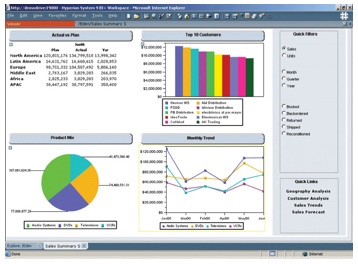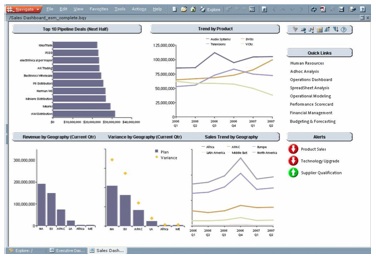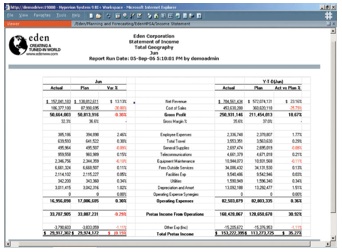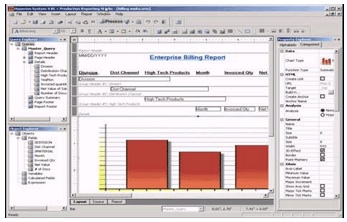A Day of Product Releases
Today was the official launch of Oracle Database 11g in New York City, whilst another event, the Oracle Fusion IT Conference, was being held at the Emirates Stadium in London. I couldn't make it to either as I was onsite with a customer, but the New York event marked the public launch of Oracle's new major database release with a number of papers and articles going up on OTN providing technical details of the new version. In particular, the papers on the OLAP Option (still short on specific details though), partitioning, compression, performance and Warehouse Builder will be of interest to data warehouse developers.
The other product launch (at least in the UK) was for Oracle BI Suite Enterprise Edition Plus. This, I believe, replaces OBIEE, costs a bit more, but includes the reporting elements of the Hyperion product suite (i.e. not Essbase or the financial planning tools). Reports back from the Emirates event suggest that Oracle are positioning the Hyperion-derived tools at the "start" and the "end" of the enterprise business intelligence process, with these new tools providing the means to do financial planning and budgeting for the organization, and with the Siebel (and now Hyperion)-derived Oracle BI Suite Enterprise Edition Plus tools providing operational business intelligence. Obviously one step towards this is folding the operational BI tools that Hyperion had (through the Brio acquisition) into Oracle's operational BI toolset, the next step is making Essbase compatible with the remaining (Siebel-derived) BI tools which is what I understand they're working on now. For the time being, you can get Essbase to extract data from the BI Server (via the ODBC client), and support for Essbase as a BI Server data source (native, via MDX I understand) is pretty close - it may even be possible via XML/A now, although I don't think this is the case.
Looking through the new OBIEE components, the first one that jumps out at me is Hyperion Web Analysis, what is presumably the front-end to Essbase, Hyperion's OLAP server.

Look at the tool, it reminds me in a way of Express Web Agent, a similar look and feel, presumably flexibility, and use of an OLAP server as the datasource. Hyperion Interactive Reporting (the old Brio, I think) has a similar slightly retro look, although as I've said before Brio developers swear by it due to it's programmability, direct database access and flexibility.

The remaining two tools, Hyperion Interactive Reporting and in particular, Hyperion SQR Production reporting, are interesting ones. On the face of it, together they're BI Publisher with a few more years development under their belt, but I doubt they've got the same next-gen architecture under the covers, which makes you wonder which of all these publishing and reporting tools Oracle will settle on as their strategic direction. Here's Hyperion Financial Reporting:

and here's Hyperion SQR Production Reporting:

which looks a lot like a cross between Oracle Reports and Oracle BI Publisher - which is what you'd expect as up until a few months ago, Hyperion were an Oracle competitor looking to have much the same set of reporting tools as their competitors.
My take on this is that existing Oracle customers aren't going to move en-masse from Reports or BI Publisher to SQR or Interactive Reporting; these tools are coming into the flagship Oracle product line to bring the Hyperion customers into the mainstream Oracle operational BI fold, and they'll still mainly appeal to legacy Hyperion/Brio users who'll keep on using them to report on their systems. One or two frustrated Discoverer (particularly Discoverer for OLAP) customers might adopt Hyperion Web Analysis and by extension Essbase, and the Hyperion Financial Reporting tool might pick up a few customers looking for a leg-up with their P&L and balance sheet reporting.
For now though, I think this is more of a placement and tidy-up exercise, bringing Hyperion's operational BI tools into the main Oracle BI product line, making Oracle BI EE a bit more attractive (and getting a bit more revenue), and positioning things in all the right places for when the main launch of Oracle's vision of integrated CPM, BI and performance management (a sort of "Grand Unified BI" theory, and one that Oracle are uniquely placed to deliver following the Hyperion aquisition) takes place later this year. It also marks the emergence of Essbase as Oracle's strategic direction for OLAP analysis, and whilst at the moment Essbase and the Essbase-based tools look a bit out on their own, my bet is that Essbase will become more and more important as the OLAP engine behind (and in front of) Oracle BI, and it probably won't be a bad idea to get yourself on an Essbase bootcamp sooner rather than later - and as all the Hyperion software has just gone up on http://edelivery.oracle.com, now's as good a time as any to download it all and start taking a look.
UPDATE: I almost forgot about Jean-Pierre Djicks's webcast and presentation on the new features in OWB11gR1 and R2. Take a look at the slides (including screenshots of early alpha versions of OWB11gR2 featuring the JDeveloper Fusion IDE as the framework) and listen to the webcast for details on what I first reported on from the ODTUG conference last month.